The History of The Hospital for Sick Children at Great Ormond Street (1852-1914)
Great Ormond Street Hospital’s growth into an internationally famous centre for child healthcare started from modest beginnings in 1852, in a converted 17th Century townhouse on the corner of Powis Place.
At the time of the Hospital’s foundation, the population of London had grown hugely in the preceding decades, following the Industrial Revolution and the end of the wars with Napoleon’s France. This growth was not, however, matched by growth in hospital provision for the City, and the few long-established general hospitals, such as St. Bartholomew’s and Guy’s, struggled to cope with the increase in demand. In these circumstances, the hospital care available to the many thousands of children living in poverty in London was minimal. A survey in 1843 revealed that, of some 2,400 patients in all the London hospitals, only 26 were children under 10 with diseases peculiar to that age; of 51,000 people dying that year in the capital 21,000 were children under ten. It was generally assumed that children were “expendable”, and in any case were better off staying with their mothers, even when seriously ill. What little healthcare that was available before Great Ormond Street Hospital opened was largely provided by various Dispensaries for Women and Children, in modern terms a cross between a pharmacy and a hospital outpatients’ department.
 Dr Charles West, the principal founder of Hospital for Sick Children at Great Ormond Street, was an expert on diseases of women and children. He had trained in medicine at Paris and Bonn, in countries where provision for children’s health was more advanced than in Britain, and where hospitals exclusively for children had long been in existence. In the 1840s, having returned to London, Dr West worked at the Universal Dispensary for Children and Women in Waterloo Road. He was determined to set up England’s first in-patient hospital for children, but failed to persuade the managers of the Dispensary to support his plan. Through his own efforts, and through social contacts made by his fellow doctor, Henry Bence-Jones, a committee was formed in 1850 with support from eminent philanthropists and public health reformers such as Lord Shaftesbury, Baroness Burdett-Coutts and Edwin Chadwick of the Board of Health.
Dr Charles West, the principal founder of Hospital for Sick Children at Great Ormond Street, was an expert on diseases of women and children. He had trained in medicine at Paris and Bonn, in countries where provision for children’s health was more advanced than in Britain, and where hospitals exclusively for children had long been in existence. In the 1840s, having returned to London, Dr West worked at the Universal Dispensary for Children and Women in Waterloo Road. He was determined to set up England’s first in-patient hospital for children, but failed to persuade the managers of the Dispensary to support his plan. Through his own efforts, and through social contacts made by his fellow doctor, Henry Bence-Jones, a committee was formed in 1850 with support from eminent philanthropists and public health reformers such as Lord Shaftesbury, Baroness Burdett-Coutts and Edwin Chadwick of the Board of Health.
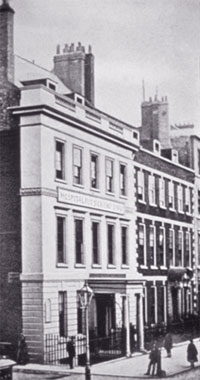 By February 1852, sufficient backing had been obtained to open The Hospital for Sick Children at No. 49 Great Ormond Street, a mansion with a previous medical connection (left). It had been the home of Queen Anne’s physician, Dr Richard Mead, 150 years earlier, and the large extension Mead had added to house his library became the first hospital ward.
By February 1852, sufficient backing had been obtained to open The Hospital for Sick Children at No. 49 Great Ormond Street, a mansion with a previous medical connection (left). It had been the home of Queen Anne’s physician, Dr Richard Mead, 150 years earlier, and the large extension Mead had added to house his library became the first hospital ward.
The engraving below shows this ward in all its glory, retaining the highly decorated ceiling and paneling on the walls. At the front of the picture to the left are Dr Jenner and Dr West tending to patients. From the early days, the Hospital managers obviously realized the importance of making the wards comfortable for children, as can be seen in the large number of toys strewn around. Apart from the two doctors, it is difficult to say precisely who all the other adults may have been, but it is likely that the two women holding children while the doctors examine them were nurses – the nurses did not wear uniforms in these early days. The other people were probably a mix of parents of the children and visitors to the hospital. Visiting hospitals was a fashionable pastime for ladies. Sometimes they came just to look, but some also came to help out, amusing the children by reading to them.
 The picture, which was first published in The Illustrated Times in April 1858, creates an image of warm and jolly place, probably a lot more welcoming than the children’s home environments. There are lots of toys to play with, and quite a few children are free to roam around. Two little ones are watching on as Dr West examines the leg of one of the children, while behind him there is a large table which a group of children are sitting at and appear to be engaged in drawing or some sort of craft activity. Right in the background is what appears to be a swing, hanging from the door frame. For all the world it looks quite like a modern ‘baby bouncer’! It wasn’t until 1875, with the opening of the ‘the Hospital in the Garden’, that the Hospital acquired purpose built wards.
The picture, which was first published in The Illustrated Times in April 1858, creates an image of warm and jolly place, probably a lot more welcoming than the children’s home environments. There are lots of toys to play with, and quite a few children are free to roam around. Two little ones are watching on as Dr West examines the leg of one of the children, while behind him there is a large table which a group of children are sitting at and appear to be engaged in drawing or some sort of craft activity. Right in the background is what appears to be a swing, hanging from the door frame. For all the world it looks quite like a modern ‘baby bouncer’! It wasn’t until 1875, with the opening of the ‘the Hospital in the Garden’, that the Hospital acquired purpose built wards.
Dr West had three principal ambitions for the Hospital, which remain the basis of its work today: the provision of healthcare to the children of the poor, the encouragement of clinical research in paediatrics, and the training of paediatric nurses. In the first years, there were only 10 beds (later increased to 20), and patients were almost all local, from the teeming slums of nearby Clerkenwell, Holborn and St. Pancras. Initially the Hospital was treated with suspicion, and few patients came, but soon its reputation began to spread across the city. Charles West was fortunate in having as a friend Britain’s leading novelist Charles Dickens, who wrote a powerful article in his popular magazine Household Words to publicize the Hospital when it opened.
In the early years, the patients were all treated in shared wards for a wide variety of conditions, from serious illnesses such as bronchitis, phthisis and syphilis to relatively minor ailments like catarrh and diarrhoea, that today would be dealt with by a General Practitioner.
The Hospital was funded by subscriptions and donations. Its services were provided free of charge, exclusively for the children of the poor. Fundraising events, such as the Annual Festival Dinner, often attracted eminent speakers, including Charles Dickens, Oscar Wilde, senior clergymen and members of the Royal Family as speakers. In some years, this one event could raise almost half the Hospital’s total income. Wealthy donors and patrons could become Governors of the Hospital and were entitled to recommend a certain number of patients for admission each year, depending on their level of contribution.
The First Ten Years
During the Hospital’s first decade, Dr West, his colleague Dr William Jenner (also Physician to the Royal Family and an expert on infectious diseases such a typhoid and diphtheria) and one Surgeon were the only clinical staff. The senior medical and surgical staff were not paid (as remained the case until the establishment of the National Health Services in 1948); they worked at the Hospital, alongside their private practices in Harley Street and elsewhere, as a social duty and for its value to their reputation and experience in dealing with a huge number of patients with very varied conditions. The state of medical knowledge in the 1850s meant that for many of the patients little could be done to cure them, but many doubtless benefited from being properly washed, fed and kept warm for probably the first time in their lives. In the first years of the Hospital, the patients’ families were allowed to help with their children’s treatment, with only five nurses to cover day and night shifts, all help was welcome. However, as with most other hospitals, a growing fear of infection being introduced (and the disruption caused by large numbers of family members being present) meant that visitors were soon excluded, except for an hour and a half on Sunday afternoons. These restrictions remained essentially the same until the 1950s, since when the arrangements have been progressively relaxed to encourage full participation by parents in their children’s treatment.
In 1858 the Hospital survived its first major financial crisis, when Charles Dickens spoke at the Festival Dinner and gave a public reading in aid of the Hospital at St. Martin-in-the-Fields church hall. This raised enough money to enable the purchase of the neighbouring house, 48 Great Ormond Street, increasing the bed capacity from 20 to 75.
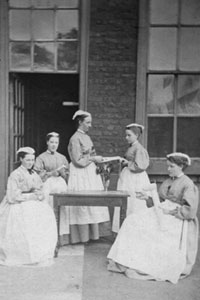 Years of Rapid Growth and New Buildings
Years of Rapid Growth and New Buildings
The 1860s saw a continuing growth in the number of patients as the Hospital’s reputation and the population of London increased. In 1860, 384 in-patients and 6,833 out-patients were treated. By 1870, the figures were 691 and 12,221. The clinical staff had grown to seven physicians, five surgeons, a dentist, a pharmacist and 24 nurses. The picture to the right shows a group of nurses sitting in the yard at the back of the hospital, c1871.
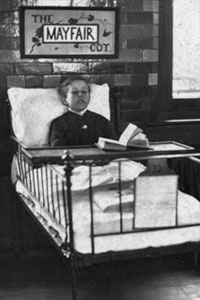 From 1868, individual beds were sponsored by wealthy benefactors, following an example set by the children’s magazine Aunt Judy. This could be done either for a fixed term or in perpetuity, depending on how much was given and remained an important source of income until the creation of the NHS. Cots were endowed in memory of Lewis Carroll, and by many others, ranging from members of the Royal Family to the racing motorist Parry Thomas and the armaments magnate Sir Basil Zaharoff. Not all cots were sponsored by the rich and famous: the ‘Mayfair Cot’, was sponsored by the children of Berkeley Chapel congregation.
From 1868, individual beds were sponsored by wealthy benefactors, following an example set by the children’s magazine Aunt Judy. This could be done either for a fixed term or in perpetuity, depending on how much was given and remained an important source of income until the creation of the NHS. Cots were endowed in memory of Lewis Carroll, and by many others, ranging from members of the Royal Family to the racing motorist Parry Thomas and the armaments magnate Sir Basil Zaharoff. Not all cots were sponsored by the rich and famous: the ‘Mayfair Cot’, was sponsored by the children of Berkeley Chapel congregation.
In a speech at the Annual Dinner, William Gladstone suggested the hospital open a country branch and in 1869 the Hospital was able to open a convalescent home at Cromwell House, the 17th Century mansion on (then still rural) Highgate Hill, which was retained until 1924.
By 1870 the original two houses containing the Hospital had become cramped and over-intensively used, and were a danger from poor sanitation and overcrowding. Dr. West and the Hospital’s Board of Management committed themselves to raising the money to pay for the construction of a new purpose-built hospital building. In this they were successful, and the new building was constructed from 1871-75along Powis Place, on the site of the gardens of the original houses (see below). An additional Isolation Block, with separate wards for infectious diseases, was opened to the north in 1878. At the time of its opening, the new building was a state of the art paediatric hospital, designed by Edward Barry, the son of the more famous Sir Charles Barry, the architect of the Houses of Parliament.
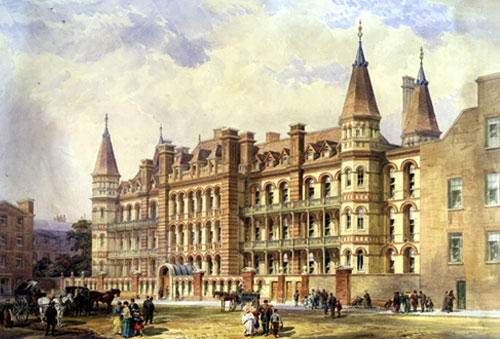 It contained 100 beds on 6 new wards, a purpose-built operating theatre, a substantial Out-Patients Department in the basement, and a sophisticated under-floor heating system. This building also contained the Hospital’s splendid Gothic chapel, endowed by the architect’s brother William Barry in memory of his wife. In 1990 when the 1875 building (by then in an advanced state of decay and having long outlived its usefulness in its original role) was demolished to make way for the new Variety Club Building, the chapel was preserved and moved on its concrete foundation by hydraulic skates to its present location, where it continues to play an important (and now more ecumenical) role in the life of the Hospital. The Foundation Stone of the 1875 building (or “The Hospital in the Garden” as it became known) was laid on 11th July 1872 by HRH The Princess of Wales, Princess Alexandra who was accompanied by HRH the Prince of Wales. Queen Victoria had been a patron of the Hospital since its inception, but this marked the beginning of a closer interest being taken by the Princes of Wales and other members of the Royal family as Patrons, an interest which continues to the present day.
It contained 100 beds on 6 new wards, a purpose-built operating theatre, a substantial Out-Patients Department in the basement, and a sophisticated under-floor heating system. This building also contained the Hospital’s splendid Gothic chapel, endowed by the architect’s brother William Barry in memory of his wife. In 1990 when the 1875 building (by then in an advanced state of decay and having long outlived its usefulness in its original role) was demolished to make way for the new Variety Club Building, the chapel was preserved and moved on its concrete foundation by hydraulic skates to its present location, where it continues to play an important (and now more ecumenical) role in the life of the Hospital. The Foundation Stone of the 1875 building (or “The Hospital in the Garden” as it became known) was laid on 11th July 1872 by HRH The Princess of Wales, Princess Alexandra who was accompanied by HRH the Prince of Wales. Queen Victoria had been a patron of the Hospital since its inception, but this marked the beginning of a closer interest being taken by the Princes of Wales and other members of the Royal family as Patrons, an interest which continues to the present day.
In the decades between the opening of the new building and the outbreak of the First World War, the Hospital continued to grow dramatically in both staff and patient numbers, and firmly established its national and international status as a teaching and research centre in paediatric illness. Thanks to the growth of both its reputation and the public transport system, the Hospital treated increasing numbers of patients from beyond the London area, from the home counties and then the rest of Britain, and also from the Colonies of the British Empire. By 1901, the 1,047 in-patients and 14,522 out-patients of 1880 had risen to 2,111 in-patients and 24,670 out-patients. Another new building with 3 large wards (the surviving red-brick frontage building) was opened in 1893, partly funded by money collected by children nation-wide as a “Jubilee Tribute” to commemorate Queen Victoria’s Silver Jubilee in 1887. This building finally replaced the original houses of the 1850s Hospital.
A Centre of Excellence
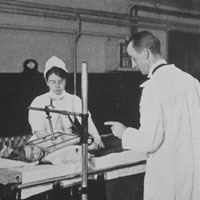 The strengths of the clinical staff continued to deepen and by 1914 the Hospital employed three Consulting Physicians, five Out-Patient Physicians and seven Surgeons. New clinical specialisms were reflected in the appointments of an Ophthalmic Surgeon (1881), an Anaesthetist (1894), a Pathologist and Bacteriologist (1901) and a Radiographer (1904). An X-Ray Department (picture left) was set up in the Hospital basement. Originally called the “Electrical Department”, it also carried out the then-fashionable sun-ray treatments.
The strengths of the clinical staff continued to deepen and by 1914 the Hospital employed three Consulting Physicians, five Out-Patient Physicians and seven Surgeons. New clinical specialisms were reflected in the appointments of an Ophthalmic Surgeon (1881), an Anaesthetist (1894), a Pathologist and Bacteriologist (1901) and a Radiographer (1904). An X-Ray Department (picture left) was set up in the Hospital basement. Originally called the “Electrical Department”, it also carried out the then-fashionable sun-ray treatments.
Doctors had been admitted to the hospital for training since it opened and courses were run over many years but in 1909 the Hospital for Sick Children Medical School opened under the First Dean, Dr. Penrose.
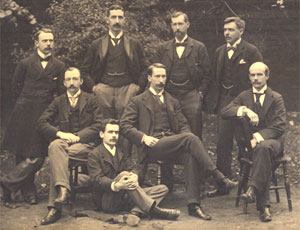 Dr Charles West had resigned from the Hospital in 1876, following personal and policy differences with the Board of Management, but continued to take a close interest in both the Hospital and paediatric medicine in general until his death in 1898. Many of his colleagues and successors on the clinical staff were or became leaders in their profession, men such as Dr William Howship Dickinson (an expert on kidney diseases), Dr Samuel Gee (coeliac disease), Dr William B Cheadle and Sir Thomas Barlow (scurvy and rickets). Barlow, later Queen Victoria’s Physician, remained on the honorary staff until his death aged 99 in 1945, establishing a record 70 years’ service to the Hospital. The next generation, in Edwardian times, produced Dr George Frederic Still (seated, right, in the photo) an expert on child rheumatism who was appointed the first Professor of Paediatrics at London University, and was arguably the first full-time paediatrician as all the other clinical staff had been generalists. Dr A E Garrod was the pioneering biochemist who laid down guidelines for metabolic disorders and became Regius Professor of Medicine at Oxford University. Dr Frederic John Poynton, another expert on rheumatism and its infectious causes, served the Hospital for 40 years, and Dr Frederic E Batten (standing, right, in photo), appointed Medical Registrar in 1892, was the inventor of pioneering orthopaedic treatments. In surgery, men such as Sir Thomas Smith and Sir William Arbuthnot Lane pioneered cleft palate and mastoid surgery, abdominal surgery for conditions such as pyloric stenosis and first used fracture plates.
Dr Charles West had resigned from the Hospital in 1876, following personal and policy differences with the Board of Management, but continued to take a close interest in both the Hospital and paediatric medicine in general until his death in 1898. Many of his colleagues and successors on the clinical staff were or became leaders in their profession, men such as Dr William Howship Dickinson (an expert on kidney diseases), Dr Samuel Gee (coeliac disease), Dr William B Cheadle and Sir Thomas Barlow (scurvy and rickets). Barlow, later Queen Victoria’s Physician, remained on the honorary staff until his death aged 99 in 1945, establishing a record 70 years’ service to the Hospital. The next generation, in Edwardian times, produced Dr George Frederic Still (seated, right, in the photo) an expert on child rheumatism who was appointed the first Professor of Paediatrics at London University, and was arguably the first full-time paediatrician as all the other clinical staff had been generalists. Dr A E Garrod was the pioneering biochemist who laid down guidelines for metabolic disorders and became Regius Professor of Medicine at Oxford University. Dr Frederic John Poynton, another expert on rheumatism and its infectious causes, served the Hospital for 40 years, and Dr Frederic E Batten (standing, right, in photo), appointed Medical Registrar in 1892, was the inventor of pioneering orthopaedic treatments. In surgery, men such as Sir Thomas Smith and Sir William Arbuthnot Lane pioneered cleft palate and mastoid surgery, abdominal surgery for conditions such as pyloric stenosis and first used fracture plates.
Nurse training had always been important to Dr West, who had written handbooks on the subject. Formal nurse training with examinations was not introduced until the early 1890s, and eventually evolved into the Charles West School of Nursing. It remained on site as a national centre for paediatric nurse training until its transfer to South Bank University, in 1995, reflecting changing national trends in nurse education.
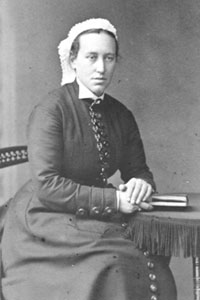 From 1883 to 1948, the Hospital also trained private nurses to work in the community and for the children of wealthier parents. The private nurses may have been the first to wear the famous pink uniforms that subsequently became the standard Hospital uniform for many decades. Catherine Wood, the Hospital’s Matron (then called “Lady-Superintendent”) from 1878-88, wrote pioneering textbooks on the theory of nursing and nursing management. She had worked at the Hospital and its Convalescent Home from the early 1860s (always as a volunteer, apart from a brief period when she requested a small salary), and was a protégé of Dr West, developing his ideas for a style of nursing and nurse training which reflected the very different needs of child patients.
From 1883 to 1948, the Hospital also trained private nurses to work in the community and for the children of wealthier parents. The private nurses may have been the first to wear the famous pink uniforms that subsequently became the standard Hospital uniform for many decades. Catherine Wood, the Hospital’s Matron (then called “Lady-Superintendent”) from 1878-88, wrote pioneering textbooks on the theory of nursing and nursing management. She had worked at the Hospital and its Convalescent Home from the early 1860s (always as a volunteer, apart from a brief period when she requested a small salary), and was a protégé of Dr West, developing his ideas for a style of nursing and nurse training which reflected the very different needs of child patients.
 By the turn of the Century, the Hospital’s Out-Patient Department in the basement of the 1875 building was becoming insufferably overcrowded, with more than 20,000 patients each year making over 70,000 individual visits. The Hospital was once again fortunate in obtaining funding from William Waldorf Astor (later Lord Astor), the American newspaper proprietor, to pay for a new free-standing Out-Patient building on Great Ormond Street. This was opened in 1908 on the site adjacent to the Hospital formerly occupied by the Working Men’s College and the Hospital and Convent of St. John & St. Elizabeth; the latter’s grim accommodation block for the nuns was retained by the Hospital as a nurses’ home until the present nurses’ home on Guilford Street was built in the 1930’s. The picture to the right is of the interior of Astor Building, showing patients waiting with their family, with the Out-patient nurse in the foreground.
By the turn of the Century, the Hospital’s Out-Patient Department in the basement of the 1875 building was becoming insufferably overcrowded, with more than 20,000 patients each year making over 70,000 individual visits. The Hospital was once again fortunate in obtaining funding from William Waldorf Astor (later Lord Astor), the American newspaper proprietor, to pay for a new free-standing Out-Patient building on Great Ormond Street. This was opened in 1908 on the site adjacent to the Hospital formerly occupied by the Working Men’s College and the Hospital and Convent of St. John & St. Elizabeth; the latter’s grim accommodation block for the nuns was retained by the Hospital as a nurses’ home until the present nurses’ home on Guilford Street was built in the 1930’s. The picture to the right is of the interior of Astor Building, showing patients waiting with their family, with the Out-patient nurse in the foreground.
For a continuation of the story of the Hospital to the modern day click here to visit the Hospital’s Archive pages.
Nicholas Baldwin M.A., M.Litt.,
Archivist,
Museum and Archives Service,
Great Ormond Street Hospital for Children NHS Trust




